High-Energy Design: Creating a Well-Lit Room with Four Types of Lighting
TASK LiGHTiNG: BOTH LEDs AND FLUORESCENTS Are up TO The Job
Task lighting is the lighting by which you do work, including undercabinet lighting in a kitchen, closet lighting, and reading lamps. The optimum task light provides shadow – free light and is located between your head and the worksurface.
Depending on the type of fixtures being used, both fluorescents and LEDs can provide effective task lighting. Fluorescent puck lights, such as those by Tresco International (www. trescointernational. com), offer shadow-free illumination along worksurfaces such as kitchen counters. Because much of today’s architecture is open plan (where one room flows into the other), choose a light with a color temperature of 2,700 K so that the color is complementary to light sources in other rooms.
For task lighting in closets and laundry rooms, consider using 5,000 K lamps from LEDs or CFLs for excellent color matching. Although some people dislike the lag time associated with CFLs, I like to use them in closets. In fact, I don’t need a sudden punch of light in the morning. I also appreciate the color rendering—very important when matching clothes—that’s possible with a combination of CFLs and LEDs.
Those energy-eating xenon and halogen festoon lamps used in undercabinet task lights and shelf lights come in LED versions; those offered by companies such as Phantom Lighting (www. phantomlighting. com)
Closet coordinated.
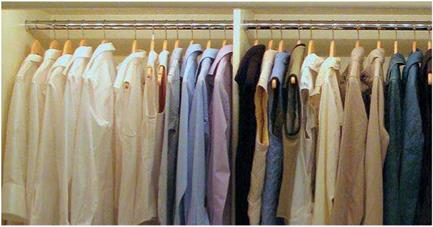 a strip of 5,000 K LED festoon lights above the clothing shows their true colors under daylight conditions (top) compared to incandescent lighting (bottom).
a strip of 5,000 K LED festoon lights above the clothing shows their true colors under daylight conditions (top) compared to incandescent lighting (bottom).
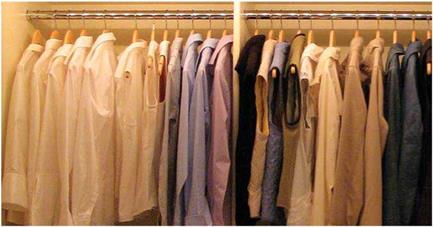
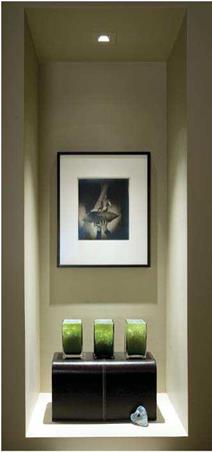
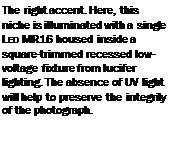
are dimmable. Other options for undercabinet task lights include LED puck lights from Lucifer Lighting (www. luciferlighting. com) and LED strip lights by Edge Lighting (www. edgelighting. com).
One caution when using LEDs as task lights: because they are point sources of illumination, they tend to create multiple shadows, which can be distracting. Hiding LED sources behind a diffusion material eliminates this problem.
Accent lighting is used to highlight specific objects, adding depth and dimension to an environment. Recessed adjustable fixtures, track lights, portable uplights, and directional landscape lights all fall into this category. Accent lighting can be very dramatic, but when overused can make the objects you own appear more important than friends
and family. This unfortunate result is often referred to as the "museum effect."
LEDs work well as accent lighting for several reasons: They provide directional light, they produce no UV (ultraviolet) rays that can harm fine artwork or textiles, and, unlike incandescents, the color temperature doesn’t alter when they are dimmed. Fluorescent light sources are usually too broad in their beam spreads to be effective as accent lights. An exception to this rule would be the illumination of a wall mural or a large hanging tapestry. In these cases, I recommend adding a UV-filter to the light fixture to reduce possible degradation of the art.
Decorative lighting also could be called architectural bling. Its purpose is simple: to look pretty and to add visual sparkle to a space. Chandeliers and candlestick-type wall
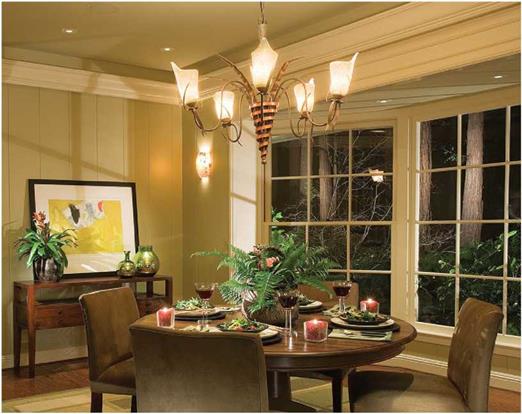 Because they can be obtained in flame – tip styles and lower wattages than typical cFLs, ccFLs are often more suitable (and less overpowering) in decorative fixtures with multiple bulbs, such as this breakfast – room chandelier.
Because they can be obtained in flame – tip styles and lower wattages than typical cFLs, ccFLs are often more suitable (and less overpowering) in decorative fixtures with multiple bulbs, such as this breakfast – room chandelier.
sconces fall into this category. Decorative lighting should not be relied on to provide primary light for a room. If it’s too bright, it can be overpowering. These fixtures were originally designed around incandescent light sources, particularly those of a low – enough wattage so as not to be overpowering. The best replacement, then, among the newer light sources would be CCFLs, because they can have a color temperature similar to that of a dimmed incandescent lamp. I particularly like the MicroBrite™ A19 by LiteTronics, which has a very warm color temperature of 2,250 K and, being a CCFL, dims down a full 90%. LEDs would have to be the worst choice for decorative lighting because they do not provide an even, overall glow.
FLUORESCENTS HAVE A SLIGHT EDGE
Ambient lighting is the gentle light that fills the volume of an interior with a warm glow. Because it is indirect light, it not only
provides overall illumination, but it also softens the shadows on people’s faces, helping them to look more relaxed and youthful. I refer to it as architectural Botox. The best ambient light comes from illumination that is bounced off the ceiling. Opaque wall sconces, torchieres, pendant-hung indirect fixtures, and cove lighting can be used to create ambient light (see "Green—and Unseen," below). Translucent fixtures can sometimes serve double-duty as both ambient and decorative light. Both LEDs and fluorescents can provide excellent ambient light.






Leave a reply